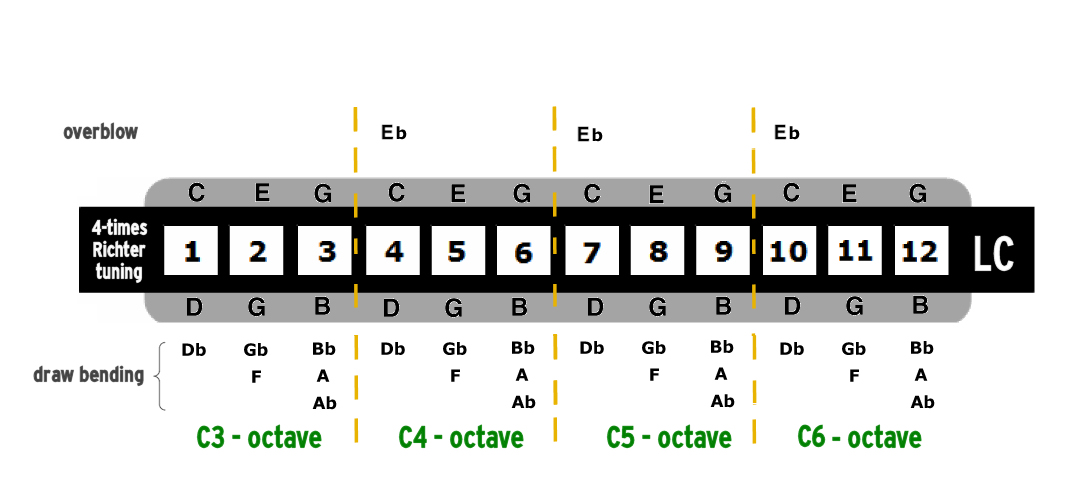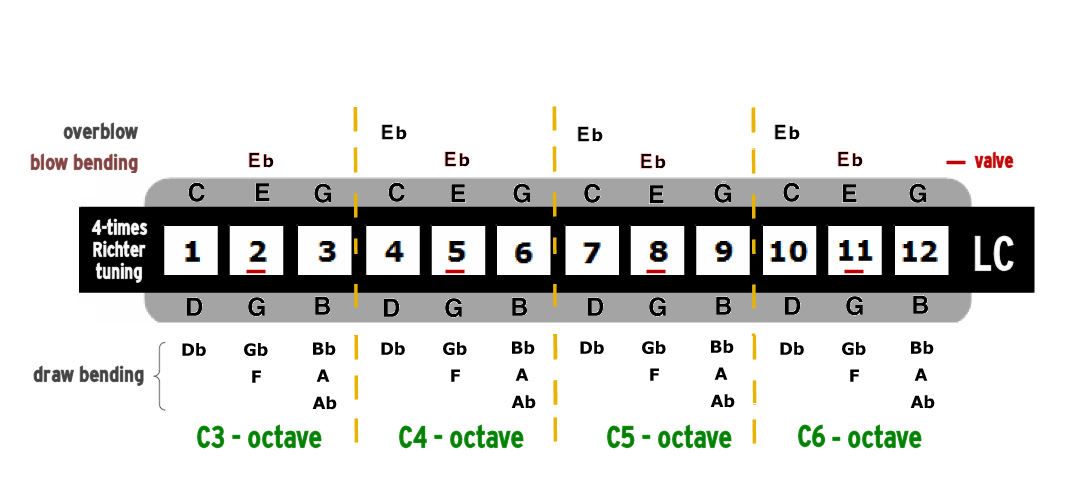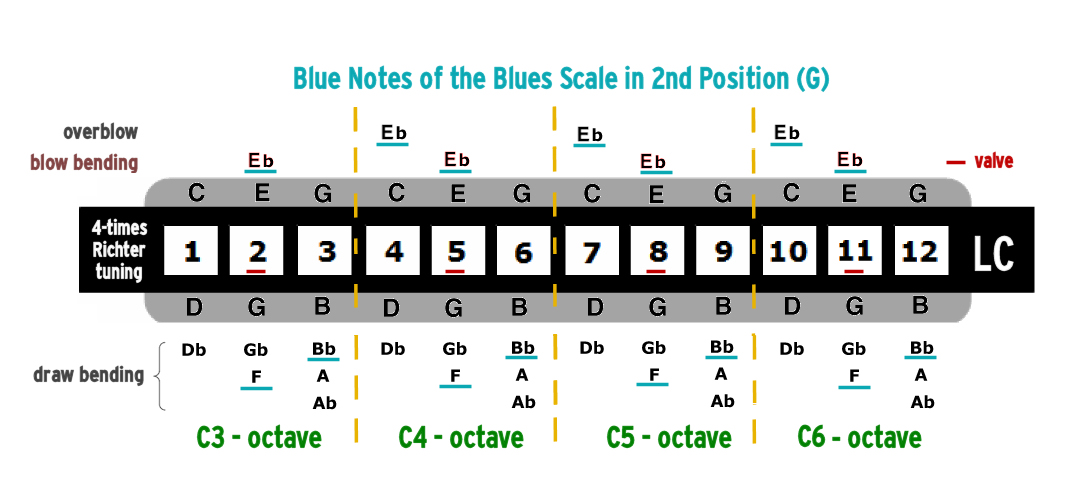Harmonica of the month - June 2015
| Tips | |
| Video | |
| 3D View | |
| Sound example |
|
| Tone table |



#harmonica_of_the_month_5: SOLIST PRO 12 STEEL Four-Times Richter LC- ended - orders needed by June 30, 2015* to start production. Current quantity sold: 27
This is #6 from this year's series of 12 Harmonicas of the Month!
Please share if you know a person who might be interested.
#harmonica_of_the_month_6
SOLIST PRO 12 STEEL - Four-Times Richter in LC
...the ideal Blues buddy
The Four-Times-Richter Tuning* is a simple and intuitive note layout for all players that mostly play Blues in 2nd position (cross-harp).
- extended body with convenient handling though there are two holes more
- wooden body, multiple coats of sealant for a resistant finish
- German silver reedplates
- stainless steel reeds in holes 1-9 and traditional brass reeds in holes 10-12
- low register available (LC)
- zipper beltbag included (refer to picture 2)
A big percentage of the incomparable bluesy sound that makes the Standard-Richter diatonic the soulful, typical and amazing soloing instrument in Blues is produced in holes 1-3 (4) if played in cross position (2nd pos).
The bending notes in holes 1-3 are the "salt in a soup of Blues improvisation” on the harmonica: sound examples and video given above!
What makes this tuning variant special?
Just imagine a typical diatonic ten hole harmonica in LC…

What happens if the note arrangement of the Richter octave (holes 1 to 3) is repeated four times on a twelve hole model?

- all blow notes stay at their places as on a Standard-Richter harmonica
- important draw bending notes become available in all registers!
- all your favorite Blues licks that are playable in holes 1 to 3 (4) (low part) now also work the same way in holes 4 to 6 (7), 7 to 9 (10) and holes 10 to 12!
- you have three registers available for your improvisation in 2nd position (G) – ideal for playing in octaves (tongue splitting) through the entire instrument

What happens if one puts a valve on the 2nd, 5th, 8th and 11th draw hole?
- another important blue note (Eb=lowered fifth) can be played by blow-bending
- the instrument can now be played fully chromatically without the need to play overblows!
- overblows 4, 7 and 9 could be played as usual if you are an overblow player
- refer to the tone table to see the exact valving

How to play the Blues scale on the Four-Times Richter tuning in 2nd position?
All notes of the Blues scale are available - everything is in place. Compared to the usual Richter diatonic the F (lowered seventh = Blue note) becomes a draw bending (-2’’, -5’’, -8’’ and –11’’) instead of a usual draw note (-5, -9).

The Blues-Scale in Tabs for 2nd position improvisation (in the key of G)
+ = blow - = draw '= semi-tone bending ''= hole tone bending o = overbend
Richter Diatonic (ten hole):
-2 -3'' +4 -4' -4 -5 +6 lower register
+6 +6o +7 -7o -8 -9 +9 upper register
To play the entire Blues scale in the upper register on a Standard Richter model you need two Overbends that may require some additional practice.
SOLIST PRO 12 STEEL - Four-Times Richter:
-2 -3'' +4 -4' -4 -5'' -5 low register
-5 -6'' +7 -7' -7 -8'' -8 middle register
-8 -9'' +10 -10' -10 -11'' -11 upper register
This simple scale give you all the notes needed for playing Blues. It is played on the Four-Times Richter, very similar to the usual Richter breathing pattern in the holes 2 to 6. It is simply repeated through all registers without the need to play any overbends (OB or OD).
Jazz players will notice that the repetition of holes 1 to 3 of a usual Richter offers all the notes of the chromatic scale through all registers – so the tuning is also really nice for all kinds of Jazzy tunes played in 2nd position major – explore this versatile Blues buddy!
*the Four-Times Richter-Tuning is also known as Super-SBS tuning
The #harmonica_of_the_month_6 is available until the end of June 2015 only.
Order now!
*You will be promptly notified and refunded if the minimum order
is not met for production of this offering.
This product is available in the key of LC only - if you like to get it in other keys use the SEYDEL >Harmonica Configurator!
Perhaps you have a useful tuning variant in your mind or would like to get a harmonica in a special design? Please >send us your ideas and suggestions! Perhaps your desired model will be the #harmonica_of_the_month one day!
This is #6 from this year's series of 12 Harmonicas of the Month!
Please share if you know a person who might be interested.
#harmonica_of_the_month_6
SOLIST PRO 12 STEEL - Four-Times Richter in LC
...the ideal Blues buddy
The Four-Times-Richter Tuning* is a simple and intuitive note layout for all players that mostly play Blues in 2nd position (cross-harp).
- extended body with convenient handling though there are two holes more
- wooden body, multiple coats of sealant for a resistant finish
- German silver reedplates
- stainless steel reeds in holes 1-9 and traditional brass reeds in holes 10-12
- low register available (LC)
- zipper beltbag included (refer to picture 2)
A big percentage of the incomparable bluesy sound that makes the Standard-Richter diatonic the soulful, typical and amazing soloing instrument in Blues is produced in holes 1-3 (4) if played in cross position (2nd pos).
The bending notes in holes 1-3 are the "salt in a soup of Blues improvisation” on the harmonica: sound examples and video given above!
What makes this tuning variant special?
Just imagine a typical diatonic ten hole harmonica in LC…

What happens if the note arrangement of the Richter octave (holes 1 to 3) is repeated four times on a twelve hole model?

- all blow notes stay at their places as on a Standard-Richter harmonica
- important draw bending notes become available in all registers!
- all your favorite Blues licks that are playable in holes 1 to 3 (4) (low part) now also work the same way in holes 4 to 6 (7), 7 to 9 (10) and holes 10 to 12!
- you have three registers available for your improvisation in 2nd position (G) – ideal for playing in octaves (tongue splitting) through the entire instrument

What happens if one puts a valve on the 2nd, 5th, 8th and 11th draw hole?
- another important blue note (Eb=lowered fifth) can be played by blow-bending
- the instrument can now be played fully chromatically without the need to play overblows!
- overblows 4, 7 and 9 could be played as usual if you are an overblow player
- refer to the tone table to see the exact valving

How to play the Blues scale on the Four-Times Richter tuning in 2nd position?
All notes of the Blues scale are available - everything is in place. Compared to the usual Richter diatonic the F (lowered seventh = Blue note) becomes a draw bending (-2’’, -5’’, -8’’ and –11’’) instead of a usual draw note (-5, -9).

The Blues-Scale in Tabs for 2nd position improvisation (in the key of G)
+ = blow - = draw '= semi-tone bending ''= hole tone bending o = overbend
Richter Diatonic (ten hole):
-2 -3'' +4 -4' -4 -5 +6 lower register
+6 +6o +7 -7o -8 -9 +9 upper register
To play the entire Blues scale in the upper register on a Standard Richter model you need two Overbends that may require some additional practice.
SOLIST PRO 12 STEEL - Four-Times Richter:
-2 -3'' +4 -4' -4 -5'' -5 low register
-5 -6'' +7 -7' -7 -8'' -8 middle register
-8 -9'' +10 -10' -10 -11'' -11 upper register
This simple scale give you all the notes needed for playing Blues. It is played on the Four-Times Richter, very similar to the usual Richter breathing pattern in the holes 2 to 6. It is simply repeated through all registers without the need to play any overbends (OB or OD).
Jazz players will notice that the repetition of holes 1 to 3 of a usual Richter offers all the notes of the chromatic scale through all registers – so the tuning is also really nice for all kinds of Jazzy tunes played in 2nd position major – explore this versatile Blues buddy!
*the Four-Times Richter-Tuning is also known as Super-SBS tuning
The #harmonica_of_the_month_6 is available until the end of June 2015 only.
Order now!
*You will be promptly notified and refunded if the minimum order
is not met for production of this offering.
This product is available in the key of LC only - if you like to get it in other keys use the SEYDEL >Harmonica Configurator!
Perhaps you have a useful tuning variant in your mind or would like to get a harmonica in a special design? Please >send us your ideas and suggestions! Perhaps your desired model will be the #harmonica_of_the_month one day!







